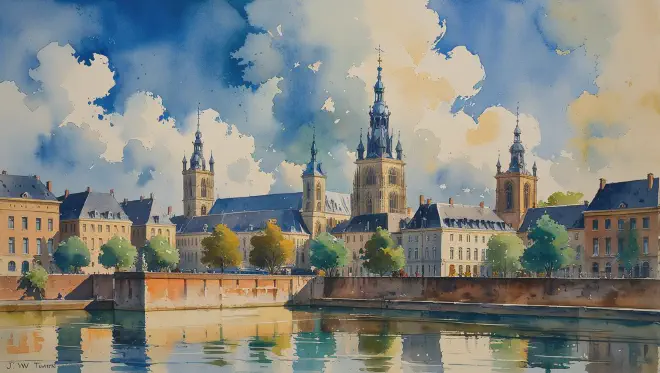Introduction
When one hears the name Waterloo, the mind inevitably drifts to that fateful battle of 1815. This small town, forever etched in history as Napoleon’s final battlefield, sits quietly about 20 kilometers south of Brussels, nestled within rolling hills that seem to whisper secrets of the past. Yet beneath the weight of historical memory lies something more tender—the gentle rhythm of Belgian countryside life and the warm embrace of its people.
Located in the French-speaking Wallonia region, Waterloo reveals itself through cobblestone streets and red-tiled roofs that catch the morning light just so. In spring, rapeseed flowers paint the fields in brilliant yellow, while autumn brings golden wheat that sways like memories in the wind. Coffee perfumes the air from small cafés, and bakeries release the comforting scent of fresh bread that wraps around street corners like an old friend’s embrace. This is a town that carries history’s weight with grace, remaining somehow pastoral and welcoming, as if it has learned the art of living peacefully with the past.

Day 1: Embraced by History’s Gentle Winds
The thirty-minute train ride from Brussels Central Station felt like a journey through time itself. When I stepped onto Waterloo station’s platform, the urban clamor dissolved into something softer, more intimate. The station building, modest yet built from weathered stone, seemed to hold stories in its very walls. The morning sun at ten o’clock cast long shadows across the platform, gentle and unhurried.
My accommodation, Pension “Au Bon Vieux Temps,” lay just a ten-minute walk from the station. The cobblestones beneath my feet created a rhythm that felt like a conversation with the past, while geraniums bloomed cheerfully in window boxes, offering silent greetings. Madame Dubois, the pension’s owner, greeted me with the refined warmth of a woman in her sixties who had perfected the art of hospitality. “Waterloo is a small town,” she said in fluent English, her smile dissolving any travel fatigue, “but I’m certain you’ll find it quite lovely.”
After settling into my room, I ventured out to explore the town center in the gentle morning light. Saint Joseph Church drew me in with its solemn bell that seemed to echo across centuries. The stone structure, dating from the 12th century, held within it a rose window that painted the interior in mystical hues. An elderly woman knelt in prayer, her quiet devotion a testament to faith that transcends time.
Lunch called from a small bistro named “Chez Léon,” where the proprietor—a jovial man in his fifties—took evident pride in showcasing local ingredients. The carbonnade flamande arrived as a masterpiece of Belgian cuisine: beef so tender it fell apart at the touch of a fork, braised in beer that added layers of complex flavor. The accompanying frites were nothing short of perfection—crispy exteriors giving way to fluffy centers, justifying Belgium’s reputation for this humble yet sublime creation.
The afternoon led me to history’s heart: the Waterloo battlefield. The Lion’s Mound (Butte du Lion) rose artificially from the landscape, crowned by a 45-meter lion statue that stood with magnificent defiance. Each of the 226 steps upward felt like a meditation on the battle that raged here two centuries ago. From the summit, green plains stretched endlessly toward the horizon, while wind caressed my face with what felt like whispers from the past.
The battlefield museum at the mound’s base offered intimate glimpses into the Napoleonic Wars through Wellington’s actual uniform, cannons that had witnessed the fury of battle, and soldiers’ letters home that made the conflict deeply personal. The panoramic exhibition room particularly moved me, with its 360-degree recreation of the battle accompanied by sound effects that made the past feel startlingly present.
Evening’s approach brought a serendipitous discovery: a small fromagerie where Pierre, the owner, became my guide through Belgium’s cheese heritage. I tasted Herve and Limburger cheeses, each bite revealing the country’s rich dairy traditions. The Herve cheese, with its intense flavor, lingered in memory long after the tasting ended.
Dinner at the pension became an intimate affair with Madame Dubois’s homemade meal. Mussels steamed in white wine achieved perfect harmony between the wine’s acidity and the shellfish’s briny sweetness, offering a taste of Belgium’s coastal bounty. Between courses, she shared local folklore with evident affection for her homeland. “The memory of battle matters,” she said thoughtfully, “but we live here in peace now. That’s what truly counts.” Her words settled in my heart like a gentle benediction.
Day 2: Where Nature and Culture Intertwine
Bird songs at six in the morning served as my natural alarm clock. Opening the window invited in crisp air perfumed with the honest scent of baking bread. The pension’s breakfast embodied Belgian simplicity at its finest: warm croissants paired with local butter and preserves, accompanied by hot chocolate so rich and deep it seemed to carry the essence of Belgian chocolate-making tradition within each sip.
The morning’s adventure took me to nearby Soignes Forest (Forêt de Soignes), just twenty minutes away by bus. This ancient woodland, once the hunting grounds of Burgundian dukes, now serves as Brussels’ precious green lung. Armed with a trail map from the entrance, I followed marked paths deeper into this living cathedral.
The forest revealed itself as another world entirely. Century-old beech and oak trees formed a living ceiling, their branches filtering sunlight into dancing patterns on the forest floor. Ferns and moss carpeted the ground, punctuated by delicate wildflowers that seemed to bloom in secret. Only bird songs and wind through leaves broke the silence, creating a sanctuary from urban noise. At a small forest pond, a curious squirrel descended from its tree to study me with bright, intelligent eyes.
A chance encounter with a Belgian family added unexpected warmth to the forest experience. Paul, the father, spoke excellent English and shared knowledge about the forest’s history and wildlife. His eight-year-old daughter Emma possessed that wonderful fearlessness of childhood, showing me interesting nuts she’d collected and gifting me a beautiful feather she’d discovered. These moments of connection transcended language barriers, touching something universal about human kindness.
Lunch arrived at “La Ferme des Saveurs,” a 200-year-old farmhouse transformed into a restaurant where stone walls and heavy beams spoke of enduring craftsmanship. Chef Antoine’s rabbit braised in beer showcased local ingredients with juniper berries and rosemary adding aromatic complexity. The meal concluded with Belgian waffles that achieved textural perfection—crispy exteriors yielding to tender centers, complemented by maple syrup and berries that sang with sweet-tart harmony.
The afternoon brought exploration of local artisan shops back in Waterloo. At “Atelier des Savoirs,” ceramicist Marianne created pottery that captured rustic elegance in equal measure. Her pieces, inspired by Belgian countryside motifs, decorated plates and vases with understated beauty. “I try to give form to memories sleeping in the clay,” she explained, her artistic philosophy resonating with the town’s own relationship to history.
The town’s small library provided evening refuge, where librarian Jean-Claude proved to be a repository of regional knowledge extending far beyond the famous battle. He shared local legends and folk tales, particularly enchanting stories about forest fairies who, according to local belief, guide lost children safely home. These gentle myths revealed a community that nurtures wonder alongside historical memory.
Night found me at “Au Vieux Waterloo,” a local tavern where conversation flowed as freely as the excellent Belgian beer. Robert, a retired teacher and regular patron, spoke passionately about regional history. “War brings sadness,” he reflected over glasses of Duvel, “but we’ve moved beyond that. What matters is carrying forward memory while building peace.” His words, spoken with quiet conviction, embodied the town’s spirit perfectly. The evening passed in warm companionship, beer creating a gentle haze of contentment.
Day 3: Endings That Feel Like Beginnings
My final morning began with a pre-dawn pilgrimage to witness sunrise from the Lion’s Mound. Walking through 5:30 AM darkness, I watched the eastern sky gradually blush with color. The sunrise from the monument’s summit became one of the journey’s most profound moments. As the sun lifted above the horizon, it transformed the green plains into a golden tapestry while morning mist created an almost ethereal landscape. Standing where fierce battle once raged, surrounded by such beauty, stirred complex emotions about history’s capacity for both destruction and renewal.
After breakfast at the pension, I explored Waterloo’s western neighborhoods previously unvisited. Here, small farms dotted pastoral landscapes where cattle grazed contentedly and an elderly shepherd guided his flock with the help of a faithful dog. Our “Bonjour” exchange, though we shared no common language, demonstrated how human warmth transcends words through simple gestures and genuine smiles.
The morning market on Saturday offered final glimpses into local life. Farmers displayed fresh vegetables, fruits, homemade bread, and artisanal cheeses with evident pride. Biting into tomatoes and cucumbers purchased fresh from the grower revealed what “sun-ripened” truly means. An elderly farm woman showed me gloves she’d knitted for her grandson, saying in careful English, “Thank you for coming from so far away.” Such moments reminded me why travel, even imaginary travel, touches the soul.
My farewell lunch at “Chez Léon” became unexpectedly special when Léon remembered my previous visit. “Your last day,” he announced warmly, “I’ll make something special.” His duck breast with cherry sauce, prepared with Belgian kriek beer, provided a fitting culinary conclusion to the journey. The dish embodied the sophistication hidden within apparent simplicity—a perfect metaphor for Waterloo itself.
Afternoon packing was interrupted by final moments with Madame Dubois, who pressed homemade cookies into my hands along with heartfelt words: “You must return someday. Waterloo will be waiting for you.” At checkout, she presented me with a watercolor painting she’d created—a sunset view from the Lion’s Mound rendered in gentle hues that captured her own gentle spirit.
Walking toward the station, I turned for one last look at the Lion’s Mound. The statue, illuminated by afternoon sun, seemed to offer a farewell salute. Every encounter from these three days remained vivid: faces of people met, flavors savored, scents of wind and flowers, all etched permanently in memory.
As the train departed, I glimpsed figures waving from the platform—strangers who somehow felt like old friends bidding farewell. Waterloo revealed itself as a small town with large-hearted inhabitants. Despite carrying war’s memory, it embraces peace and welcomes visitors with genuine warmth.
In Closing: What Feels Real in the Realm of Imagination
Gazing at my reflection in the Brussels-bound train window, I found myself reviewing three days that somehow felt both imaginary and absolutely real. Waterloo had surprised me completely—rather than the somber weight I’d expected from its name, I discovered a place vibrant with life and human warmth. While historical gravity permeated the experience, it was the present-moment vitality of its people that made the journey truly memorable.
Madame Dubois’s gentle smile, Léon’s jovial personality, the warmth of the forest family, Jean-Claude’s scholarly passion, the tavern conversations—each encounter contributed unique threads to the journey’s tapestry. Through these interactions, I glimpsed not just Belgium’s deep culture but also its people’s approach to living meaningfully.
Above all, this journey illuminated peace’s precious value. Where fierce battles once raged, cattle now graze peacefully and children’s laughter fills the air. The residents’ ability to honor history without being imprisoned by it, to treasure the present while respecting the past, proved deeply moving.
Though this journey existed only in imagination, my heart holds clear memories of walking Waterloo’s cobblestones and meeting its warm-hearted people. Perhaps this is travel’s true essence—the experiences that touch us, whether real or imagined, never fade from memory. Should I ever actually visit Waterloo, I’ll search for faces resembling those from this imaginary journey. Somewhere, I’m certain, similar warm smiles await discovery.

